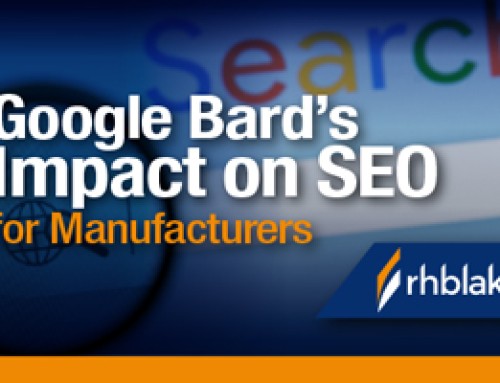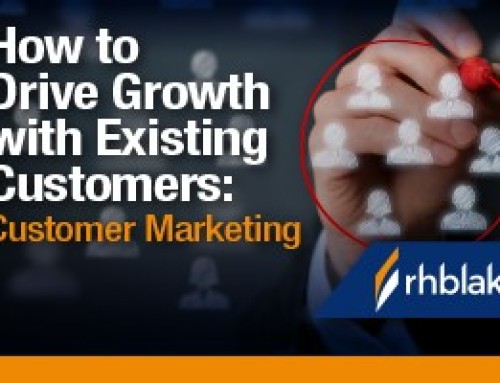Your next best option? Use cases. In fact, in some situations, it could be the preferred choice.
How Manufacturers Can Earn Credibility and Trust with Use Cases
Written by Dan Konstantinovsky
Strategic Marketing, RH Blake
While B2B case studies are arguably one of the most effective ways to demonstrate expertise in a market, they’re often difficult to produce—and at times not even possible.
Your next best option? Use cases. In fact, in some situations, it could be the preferred choice.
As B2B marketers for manufacturing and industrial firms, we all know too well the hurdles and headaches associated with creating case studies:
- Clients unwilling to participate
- Company policies against any form of supplier endorsement
- Long project timelines and approval processes
- Lengthy time in use before the solution proves successful
- Clients not inclined to provide publishable results
Now consider when producing a case study isn’t even an option, such as product launches or selling into a new vertical market. There is simply no available customer story to tell.
Whenever faced with the above issues, try use cases. They’re an effective alternative for building the credibility necessary to influence buying preference.
What’s the difference between a B2B case study and a use case?
A case study focuses on an actual company’s success with a solution. It’s a real-world proof point.
A use case focuses on a particular situation and the process of how a solution addresses it. It’s about picturing the possibilities.
I’m not debating which is better. Hands down a case study is marketing gold. What we’ve seen is that use cases are also extremely valuable for marketing. Here’s why:
B2B marketing benefits of use cases
You control all aspects of the narrative. With use cases, you have full command of how you wish to position and present the story—there’s no dependence on what a customer is willing to approve.
Demonstrates to a specific customer role how you solve their problem. Use cases let you zero in on a specific pain point for a particular role and explain how your solution addresses the situation. You can produce this type of highly relevant content for multiple situations and numerous customer profiles.
Helps customers visualize the possibilities. While the same could be said for a case study, use cases are more flexible because they aren’t tied to a single customer’s story and application. You can be concise and specific or as broad as you need to be to support your marketing strategy.
Creates content hooks to engage readers faster. Incorporating use cases as sidebars or callouts on your website and in collateral is ideal for capturing audience interest, especially considering that the majority are skim readers. Clearly and quickly seeing content that’s relevant increases engagement and starts to build trust.
Tests what’s important to your target audience. When implemented online, you can measure audience engagement with your use cases. Which ones are they clicking on? What’s the dwell time? Did a particular use case generate leads? With this knowledge, you can emphasis certain content or expand it for your marketing efforts.
Faster to produce. Use case development only requires the expertise of in-house resources. You aren’t restricted by a customer’s schedule or the typically lengthy review and approval process as with case studies.
So what does a use case for B2B marketing look like?
Use cases can exist in any format, from a white paper to a video to a blog post.
In this use case video, the story illustrates the benefits of a more intuitive and cost-effective control system.
In this solutions video, a use case illustrates how customers can simplify collecting data from a motor via the cloud.
In this healthcare-focused one, the use case is broad. It involves moving supplies to reduce noise levels and improve HCAHPS scores.
As you can see even in just these video examples, you have a lot of flexibility in the ways you can present a use case.
How to develop compelling use cases for B2B marketing
Here are seven tips that we follow when creating use cases for our clients. You too can apply these to your efforts.
- Define the challenges a target persona faces. Start with the ones that you believe are the persona’s most-pressing issues. Your product marketing team or subject matter experts likely already have a list.
- Explain how your solution solves each challenge and helps customers achieve their business goals. Focus on clarity and conciseness. Even if the solution is complex, sounding so at any point in the buying journey can be dissuasive.
- Develop short- and long-form content. Prepare your content to be used across channels and for multiple marketing efforts.
- Tell a story. Use storytelling best practices to create engaging and relatable content that feels as real world as possible.
- Avoid selling. Stick to the situation and solution. It’s easy to fall into the trap of wanting to sell the solution. Just remember the use case demonstrates how the solution addresses the challenge, so its already selling itself without the promotional content.
- Add visuals to communicate the process and benefits. A good visual can do wonders. It accelerates audience understanding.
- Consider video. It’s a highly consumed format by just about everyone these days.
Turn use cases into powerfully persuasive content
The manufacturing prospects we pursue as B2B marketers are incredibly risk averse. So anything we can do to quickly establish credibility and build trust will help accelerate the buying journey.
Use cases can help you accomplish that. Our experience shows that when carefully planned and properly implemented, use cases successfully generate attention with targeted audiences, as well as improve lead generation efforts involving product launches and during entry into new markets.
How Manufacturers Can Earn Credibility and Trust with Use Cases
Written by Dan Konstantinovsky
Strategic Marketing, RH Blake
While B2B case studies are arguably one of the most effective ways to demonstrate expertise in a market, they’re often difficult to produce—and at times not even possible.
Your next best option? Use cases. In fact, in some situations, it could be the preferred choice.
As B2B marketers for manufacturing and industrial firms, we all know too well the hurdles and headaches associated with creating case studies:
- Clients unwilling to participate
- Company policies against any form of supplier endorsement
- Long project timelines and approval processes
- Lengthy time in use before the solution proves successful
- Clients not inclined to provide publishable results
Now consider when producing a case study isn’t even an option, such as product launches or selling into a new vertical market. There is simply no available customer story to tell.
Whenever faced with the above issues, try use cases. They’re an effective alternative for building the credibility necessary to influence buying preference.
What’s the difference between a B2B case study and a use case?
A case study focuses on an actual company’s success with a solution. It’s a real-world proof point.
A use case focuses on a particular situation and the process of how a solution addresses it. It’s about picturing the possibilities.
I’m not debating which is better. Hands down a case study is marketing gold. What we’ve seen is that use cases are also extremely valuable for marketing. Here’s why:

Use Case Template for
B2B Manufacturers
B2B marketing benefits of use cases
You control all aspects of the narrative. With use cases, you have full command of how you wish to position and present the story—there’s no dependence on what a customer is willing to approve.
Demonstrates to a specific customer role how you solve their problem. Use cases let you zero in on a specific pain point for a particular role and explain how your solution addresses the situation. You can produce this type of highly relevant content for multiple situations and numerous customer profiles.
Helps customers visualize the possibilities. While the same could be said for a case study, use cases are more flexible because they aren’t tied to a single customer’s story and application. You can be concise and specific or as broad as you need to be to support your marketing strategy.
Creates content hooks to engage readers faster. Incorporating use cases as sidebars or callouts on your website and in collateral is ideal for capturing audience interest, especially considering that the majority are skim readers. Clearly and quickly seeing content that’s relevant increases engagement and starts to build trust.
Tests what’s important to your target audience. When implemented online, you can measure audience engagement with your use cases. Which ones are they clicking on? What’s the dwell time? Did a particular use case generate leads? With this knowledge, you can emphasis certain content or expand it for your marketing efforts.
Faster to produce. Use case development only requires the expertise of in-house resources. You aren’t restricted by a customer’s schedule or the typically lengthy review and approval process as with case studies.
So what does a use case for B2B marketing look like?
Use cases can exist in any format, from a white paper to a video to a blog post.
In this use case video, the story illustrates the benefits of a more intuitive and cost-effective control system.
In this solution video, a use case illustrates how customers can simplify collecting data from a motor via the cloud.
In this healthcare one, the use case is broad. It involves moving supplies to reduce noise levels and improve HCAHPS scores.
As you can see even in just these video examples, you have a lot of flexibility in the ways you can present a use case.
How to develop compelling use cases for B2B marketing
Here are seven tips that we follow when creating use cases for our clients. You too can apply these to your efforts.
- Define the challenges a target persona faces. Start with the ones that you believe are the persona’s most-pressing issues. Your product marketing team or subject matter experts likely already have a list.
- Explain how your solution solves each challenge and helps customers achieve their business goals. Focus on clarity and conciseness. Even if the solution is complex, sounding so at any point in the buying journey can be dissuasive.
- Develop short- and long-form content. Prepare your content to be used across channels and for multiple marketing efforts.
- Tell a story. Use storytelling best practices to create engaging and relatable content that feels as real world as possible.
- Avoid selling. Stick to the situation and solution. It’s easy to fall into the trap of wanting to sell the solution. Just remember the use case demonstrates how the solution addresses the challenge, so its already selling itself without the promotional content.
- Add visuals to communicate the process and benefits. A good visual can do wonders. It accelerates audience understanding.
- Consider video. It’s a highly consumed format by just about everyone these days.
Turn use cases into powerfully persuasive content
The manufacturing prospects we pursue as B2B marketers are incredibly risk averse. So anything we can do to quickly establish credibility and build trust will help accelerate the buying journey.
Use cases can help you accomplish that. Our experience shows that when carefully planned and properly implemented, use cases successfully generate attention with targeted audiences, as well as improve lead generation efforts involving product launches and during entry into new markets.









